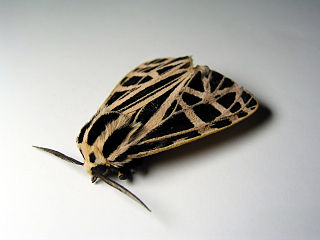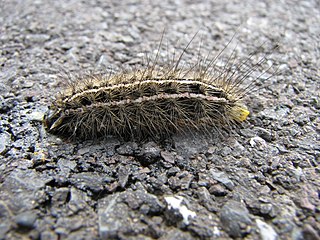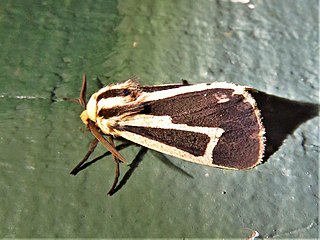
The Arctiinae are a large and diverse subfamily of moths with around 11,000 species found all over the world, including 6,000 neotropical species. This subfamily includes the groups commonly known as tiger moths, which usually have bright colours, footmen, which are usually much drabber, lichen moths, and wasp moths. Many species have "hairy" caterpillars that are popularly known as woolly bears or woolly worms. The scientific name Arctiinae refers to this hairiness. Some species within the Arctiinae have the word "tussock"' in their common names because they have been misidentified as members of the Lymantriinae subfamily based on the characteristics of the larvae.

Apantesis is a genus of tiger moths in the family Erebidae first described by Francis Walker in 1855. They are found in North and Central America.

Apantesis quenseli, the Labrador tiger moth, is a moth of the family Erebidae. In Central Europe the species is found in the Central Alps at altitudes of 2,000–2,700 metres (6,600–8,900 ft). They are also present in Northern Scandinavia. It is widely distributed in Polar Eurasia, mountains of Siberia, Mongolia, North China, Japan, Polar North America.

The parthenice tiger moth is a moth of the family Erebidae. It is found in south-eastern Canada, and the eastern United States. The moths are common in fields and woodland edges from June to late September. The moth is nocturnal and is attracted to light sources.

Apantesis phalerata, commonly known as the harnessed tiger moth, is a species of moth within the Erebidae family, first described by Thaddeus William Harris in 1841.

Apantesis arge, the arge moth or arge tiger moth, is a moth of the family Erebidae. The species was first described by Dru Drury in 1773. It is found in North America from Quebec and Maine to Florida, West to New Mexico, North to North Dakota and Ontario.

Apantesis virgo, the virgin tiger moth, is a moth of the family Erebidae. The species was first described by Carl Linnaeus in his 1758 10th edition of Systema Naturae. It is found in North America from Newfoundland south to Florida west to Alberta.

Apantesis nais, the Nais tiger moth, is a moth of the family Erebidae. It was described by Dru Drury in 1773.

Apantesis vittata, the banded tiger moth, is a moth of the family Erebidae. It was described by Johan Christian Fabricius in 1787. It is found in the United States from Maryland to Florida, west to Kentucky and Louisiana.
Apantesis allectans is a moth of the family Erebidae. It was described by Douglas C. Ferguson in 1985. It is found in the Mexican states of Durango and Sonora and the Chiricahua Mountains of southern Arizona in the United States. The habitat consists of open montane pine forests.

Apantesis anna, the Anna tiger moth, is a moth of the family Erebidae. It was described by Augustus Radcliffe Grote in 1863. It is found from Maine to the mountains of North Carolina, west to Nebraska and Arkansas.
Apantesis doris, the Doris tiger moth, is a moth of the family Erebidae. It was described by Jean Baptiste Boisduval in 1869. It is found in North America from British Columbia, northern Idaho, Alberta and western Montana. In the east, it is found in the Atlantic Coast provinces and from Nova Scotia to northern Florida and west to central Texas. The habitat consists of open willow/sedge fens and probably other open wetlands in the boreal forest.

Apantesis nevadensis, the Nevada tiger moth, is a moth of the family Erebidae. It was described by Augustus Radcliffe Grote and Coleman Townsend Robinson in 1866. It is found in the Pacific Northwest of North America, as well as the inter mountain region and the Rocky Mountain states. In Canada, it is found in Alberta and southern Saskatchewan and Manitoba. The habitat consists of deserts, juniper woodlands and open sagebrush range-lands, as well as open forests.

Apantesis ornata, the ornate tiger moth or achaia moth, is a moth of the family Erebidae. It was described by Alpheus Spring Packard in 1864. It is found in western North America from southern British Columbia through the Pacific Northwest to southern California, northern Utah, and western Wyoming and Montana. It is found in a wide range of habitats, including open woodland.
Apantesis philipiana is a moth of the family Erebidae. It was described by Douglas C. Ferguson in 1985. It is found in the far northwest of North America from Wrangel Island west to Mackenzie Delta in the Northwest Territories and south to Denali National Park in Alaska. It was named in honor of Kenelm Philip, a lepidopterist who started and ran the Alaska Lepidoptera Survey from 1970 to 2014.

Apantesis phyllira, the phyllira tiger moth, is a moth of the family Erebidae. It was described by Dru Drury in 1773. It is found in North America from Quebec and New England south to Florida and west to Texas, Colorado and Alberta. The habitat consists of dry, open woodland and grassland. The species is listed as endangered in Connecticut.
Apantesis placentia, the placentia tiger moth, is a moth of the family Erebidae. It was described by James Edward Smith in 1797. It is found in the south-eastern United States, from New Jersey to Florida. The habitat consists of dry, sandy open wooded areas, primarily pine barrens.
Apantesis williamsii, or Williams' tiger moth, is a moth of the family Erebidae. It was described by Charles R. Dodge in 1871. It is found in North America from the Northwest Territories east to the northern Great Lakes region, New Brunswick and New England. It also occurs throughout the northern Great Plains, south at higher elevations to Arizona and New Mexico, west to south-eastern British Columbia and eastern California.

Apantesis proxima, the Mexican tiger moth, is a moth of the family Erebidae. It was described by Felix Guérin-Méneville in 1844.












